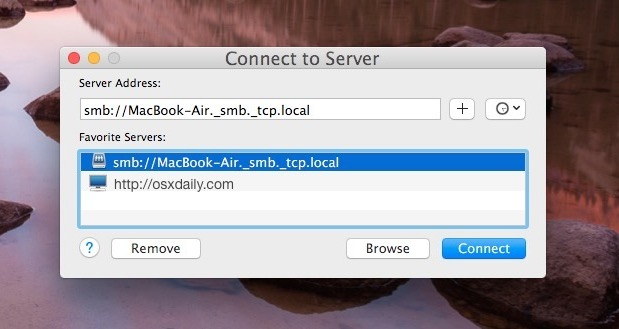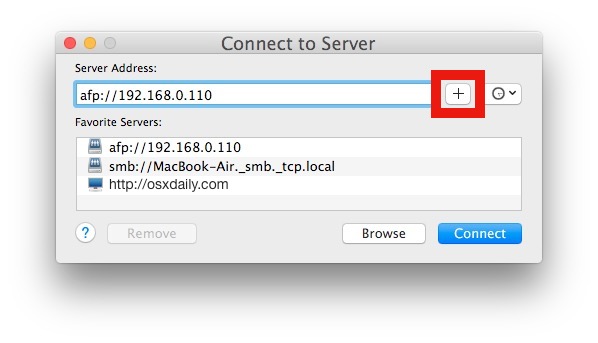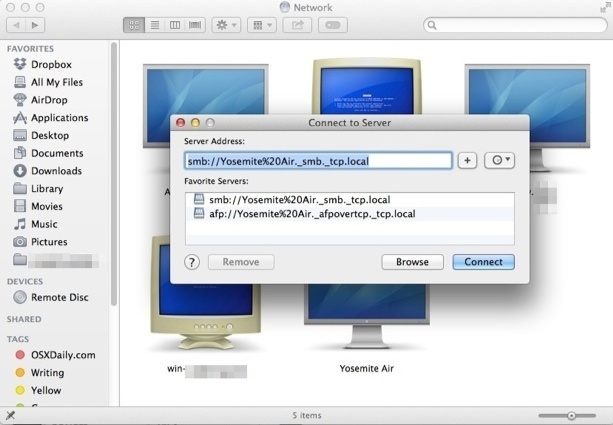Connect to a Server Often from Mac? Add it to Favorite Server List in OS X

If you find yourself frequently connecting to a network share or remote server from your Mac, you should do yourself a favorite and add it to the Favorites list in the Connect to Server screen of Mac OS X. Though the feature is right in front of our faces, very few Mac users seem to use this handy ability, though it will undoubtedly make your networked life easier.
Using it is pretty simple, and you can favorite many types of server or network shares, be it another Mac (AFP), Windows PC or Linux (SMB), FTP, FTPS, VNC, amongst others. Let’s cover the basics and understand how to use Connect to Server and the simple Favorites option:
Connect to a Favorite Server from Mac OS
- From the Mac OS X Finder or Desktop, pull down the “Go” menu and choose “Connect to Server” (or hit Command+K to bring up the “Connect to Server” screen)
- Enter the networked server destination address* as usual, often this is an IP address in the format of something like: afp://192.100.1.155
- Before hitting “Connect”, click the [+] plus button to add the target server to the favorites list, this will appear directly below the server address field in the “Favorite Servers” list
* Note that you can also browse servers and connect that way, which will then appear in the Recents list.

Now when you want to connect to that server again, rather than entering the full target IP address or network share name, just hit Command+Shift+K and select the favorited server from the list below. Selecting something from the Favorites list will populate the address field instantly, but you can edit it if desired. As a side note, targeting the IP and adding it to the Favorite list can be a meaningful workaround to LAN discovery issues in OS X, particularly when attempting to connect from older versions to newer OS X versions.
Something to keep in mind is that once a network share has been found or favorited, anytime it is located, it will also appear in the “Shared” section of a Finder window sidebar for quick access. Assuming the login authentication is saved and cached, accessing it directly from a sidebar will open the shared volume/server in the Finder as usual:

Additionally, these servers will be available in the Network window, this applies to all versions of OS X.

For those who want to go beyond just having an easily accessible “Favorite Server” list, the Connect to Server function in OS X can be taken a step further and basically turned into a Mac version of a mapped network drive from the Windows world, with persistent connections over reboots, logins, and rapid re-connections from an alias. That’s particularly handy for Macs that are on a LAN or who frequently access a network drive or file sharing server.
And yes, this works to favorite FTP and FTPS servers, if you’re a fan of the built-in FTP client of OS X too.
While this works to connect to any Mac or Windows / Samba shares, there are plenty of other ways to share files Mac-to-Mac as well, so if you find this to be unreliable or inconsistent, alternatives for file transfers are out there.


Very good info. Lucky me I ran across your site by accident (stumbleupon).
I have book-marked it for later!
How do I change the name or label of a favorite? I could not find a way in macOS High Sierra 10.13.6. Even a terminal command or some 3rd party utility would be fine.
I am stumped with a Mac that has a “Ghost” file that is preventing me to connect to any server. Even random numbers in the server address cause this error message to pop up that is can’t find this particular file.
How do I make this Mac running High Sierra forget this old path?
System Preferences > Users & Groups > MyAccount > Login Items…
Just drop mounted network wolume to Login Items list. Simple.
Where is this mythical GO menu?!!!
Finder menu bar.
Aiming to divert materials away from landfills and send it for recycling they offer the double advantage of reducing
the amount of trash in landfills and creating a greener environment.
The average household sends some 10 kilograms of waste to landfill every week which is highly wasteful as much of the material can be re-used or recycled.
But, Vo – IP systems provide a great way to use more of the computer and Internet
resources that are already available instead of taking the time to
create and use more.
This is some of the most annoying tool in the OSX. FTP connection is read-only and there is no SSH support.
Is there something particular that you are trying to do with ssh that is not working? I use ssh (and scp) almost daily, and it seems to be fine.
OS X Finder based FTPS works fine, most FTP (and sFTP) servers support FTP over SSL (FTPS) so that’s no big deal.
But you can always use the command line for sftp, ssh, scp too.
@Neil
Browsing files and get them in GUI, I have no problems with cli but it’s 2015 now dude?
@Davis
no big deal to have only read-only access in ftp mounts in Finder? Serious?
Fair enough — I’d never have thought of that!
Is there a similar utility to DAVE 2.0?
I used to use DAVE in my OS 9 days to connect to my uni network and see all Windows 95/ 98PCs. I could then drop files into colleagues shared folders .. all from my Performa.
DAVE allowed me to see lots of computers, not just the one i mapped to.
Thanks.
Yes absolutely, the DAVE utility is still around for OS X http://www.thursby.com/products/dave
If the Macs and PCs are on the same network, you should be able to see them in the Network window and the “Shared” list in the Finder sidebar. Sometimes they have to be discovered first, but with OS X Mavericks it’s pretty reliable.
Sometimes and on some networks, OS X Yosemite is a bit less reliable with discovery on a local network, which is why we recommend pointing directly at an IP whenever possible, you can read more about that here:
https://osxdaily.com/2015/01/24/workaround-problem-connecting-to-server-mac-os-x-lan-discovery-error/
The “Connect to Server” window is just slightly better than nothing. You can’t sort or reorder items in the list, let alone organize them into folders (or organize them in any way whatsoever).
I use a Mini at work and have two SMB shares I use daily. I added the volumes from the shared section of the finder sidebar to the Login Items for my user profile.
When I login or reboot, these auto mount thus avoiding the Command+Shift+K step to selectively mount them.